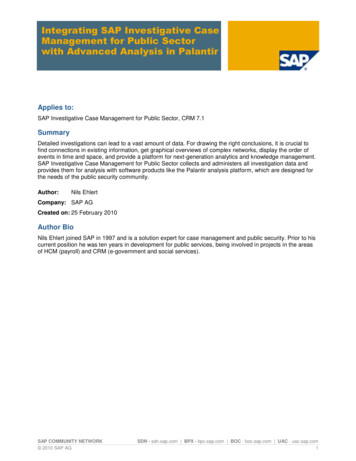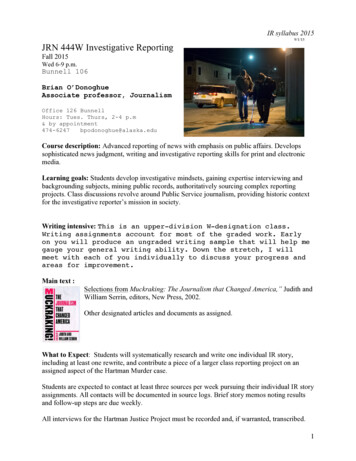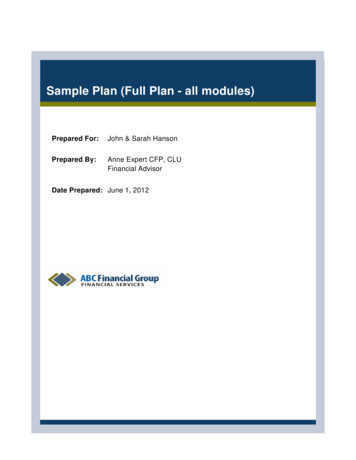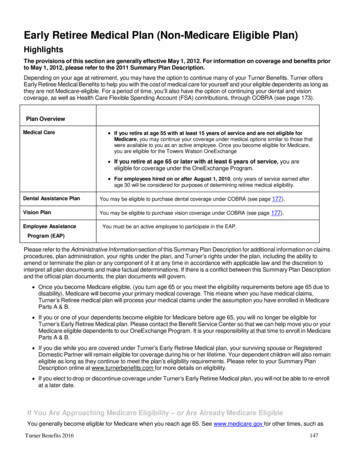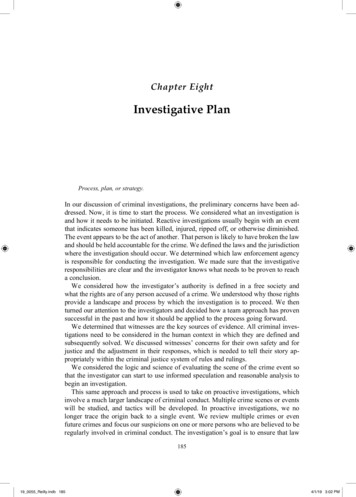
Transcription
Chapter EightInvestigative PlanProcess, plan, or strategy.In our discussion of criminal investigations, the preliminary concerns have been addressed. Now, it is time to start the process. We considered what an investigation isand how it needs to be initiated. Reactive investigations usually begin with an eventthat indicates someone has been killed, injured, ripped off, or otherwise diminished.The event appears to be the act of another. That person is likely to have broken the lawand should be held accountable for the crime. We defined the laws and the jurisdictionwhere the investigation should occur. We determined which law enforcement agencyis responsible for conducting the investigation. We made sure that the investigativeresponsibilities are clear and the investigator knows what needs to be proven to reacha conclusion.We considered how the investigator’s authority is defined in a free society andwhat the rights are of any person accused of a crime. We understood why those rightsprovide a landscape and process by which the investigation is to proceed. We thenturned our attention to the investigators and decided how a team approach has provensuccessful in the past and how it should be applied to the process going forward.We determined that witnesses are the key sources of evidence. All criminal investigations need to be considered in the human context in which they are defined andsubsequently solved. We discussed witnesses’ concerns for their own safety and forjustice and the adjustment in their responses, which is needed to tell their story appropriately within the criminal justice system of rules and rulings.We considered the logic and science of evaluating the scene of the crime event sothat the investigator can start to use informed speculation and reasonable analysis tobegin an investigation.This same approach and process is used to take on proactive investigations, whichinvolve a much larger landscape of criminal conduct. Multiple crime scenes or eventswill be studied, and tactics will be developed. In proactive investigations, we nolonger trace the origin back to a single event. We review multiple crimes or evenfuture crimes and focus our suspicions on one or more persons who are believed to beregularly involved in criminal conduct. The investigation’s goal is to ensure that law18519 0055 Reilly.indb 1854/1/19 3:02 PM
186Chapter Eightenforcement intelligence or suspicion evolves to the point where crimes are solved,and certain patterns of criminal activity are eliminated.THE PLANAn investigative plan includes speculative analysis based on experience and logic.The facts and evidence available to the investigator after the initial introductory phaseof an investigation are reviewed, and certain determinations about that crime aremade. A good working plan begins with answering the following basic questions andestablishing the best way to apply the answers to a specific set of facts. What criminal statute or statutes were violated?Does the investigator and the agency have jurisdiction?How large is the population of suspects who could have committed the crime?Does the investigator have the authority to effectively resolve all the questionsraised by the crime event or series of events under investigation? Is there a pool of witnesses who can be helpful in the investigation? Is the crime solvable based on reliable witnesses; a reliable intelligence base; orthe recovery of physical evidence, which can provide forensic identification of thesuspect?A plan should be a predictable road map leading to a solution of the crime. Cohesiveorganization with a step-by-step process should provide the best approach, but thereare as many variables as there are constants when you consider the nature of proof,the value of evidence, and the determination about how facts are best used to proveor support an argument. The criminal investigator needs to understand that, from onecase to another, it is rare that the same process will yield the same results. Investigation is not just science, psychology, or precise planning. It may be all three, but thereare times when an investigation presents as chaos that turns into an understandableand orderly process by the criminal. Some violent crimes, for instance, may appear tobe random violence with no motive. As the investigation evolves, the criminal’s planbecomes apparent and almost predictable. A plan, therefore, must be malleable andadaptable. As soon as the investigator begins to uncover what is going on in the mindof the criminal, a more orderly path to solution will be available.In an investigation, there are certain factors that hopefully will always be available.Each investigation needs at least one witness who can testify about the crime, or thecriminal, or even just about circumstances relating to the crime. Each investigationneeds at least one victim and one criminal. Aside from these needs, the possibilitiesare endless. Even so-called victimless crimes may affect the investigative plan. Wellorganized and precise plans reflect the criminal investigator’s capabilities and theteamwork that is applied to the investigation.The most important goal of a plan is effectiveness and success. If the facts, evidence, and proof come together and present the truth for a judge or jury and the criminal is made to pay for the action, the case is a success and the plan worked. In our19 0055 Reilly.indb 1864/1/19 3:02 PM
Investigative Plan187discussion, we will present steps that can be followed that will result in a successfulinvestigation. You will note that the steps are multifaceted and may appear to be ajumble of disparate processes, but this is how criminal cases manifest themselves. Theinvestigator is usually hit with multiple needs all at once, and throughout the steps, thelimits of time management and organization are tested until all the leads are covered.Then, there is dead time and space during which the investigator must be creative,patient, and sustained in applying pressure to achieve the goal. Law enforcement workis a process of daily routine and boredom, which is then punctuated by sheer terror andsustained emergency demands. In following certain steps, there are points at whichthe investigator can adjust, implement decisions, and produce much-needed supportto reach the goal.After the initial investigative step has been completed, the plan usually becomes anexercise with one or more theories being considered and determining the answers towho, what, where, how, why, and when the crime was done. Most of the time withreactive crime investigations, the what and where are self-evident. Occasionally, thewhen is also known. In some cases, such as commercial armed robberies, the crimemight have happened in front of several eyewitnesses. The theory or speculation aboutwhat happened is not a mystery. In homicide investigations, it is more demandingwhen investigators are called to the scene of a deceased person. Crimes that occurredwithout a definitive crime scene are even that much more demanding. The initial information that a crime occurred may be supported by one or more witnesses, but nophysical evidence is immediately available. The theory or speculation develops fromthe details provided by the complaining witness, as in a kidnapping case.Investigative inquiry is a waste of time and effort if there is no reliable source ofinformation upon which to base a theory or speculation about the crime. The sourcesof that information are a physical crime scene or dump site, knowledgeable and reliable witnesses, and victims and then any other supporting information that exists andallows progress in an investigation.The two types of investigations have two separate starting points. A reactive caseusually begins with the crime scene. If there is no known crime scene, then begin withthe complainant who reports the crime to law enforcement. Once the crime scene hasbeen established, proceed as follows:1. Determine if there are witnesses and or victims to the crime present and conductinitial interviews.2. Begin the detailing of leads that need to be followed.3. Coordinate with the crime scene examiners. If there is no crime scene team or unit,begin processing the scene yourself.4. Go over the actions of the first responders, and make sure they send you any notes,photos, or reports they generate. (In the current state of technology, these itemsmay be digital files, which will eventually find their way into the investigative file.)5. If appropriate, determine if there is outstanding investigative or tactical activity being carried out by responding patrol units. (This outstanding activity may involvefollowing up on a lookout for a getaway car or a suspect who matches the description of the criminal.)19 0055 Reilly.indb 1874/1/19 3:02 PM
188Chapter EightThese five procedures are prominent examples of the investigative actions that needto be taken when responding to a crime. They can be adjusted and applied to everyinvestigation; even proactive investigations will have multiple crime events that haveto be reviewed for this same basic information.In a proactive investigation, begin with a thorough background investigation of thesuspects identified in the case as being responsible for a pattern of criminal conduct.It is also a starting point to begin with the crime reports, crime scene examinations,witness statements, and any follow-up significant physical evidence recovered. Proactive investigations often have known (or unknown) suspects who are responsible forthe pattern of crime. Focus is on the suspected pattern of crimes or the backgroundsof the suspects themselves. Most proactive investigations are initiated by reviewingreports, statements, photographs, and any evidence related to the investigation. Theinvestigator must become thoroughly knowledgeable about all aspects of the suspectsor the suspected activity.Most proactive investigations are initiated by actionable intelligence that is reliableand can be accessed for further information when the case is advanced to the secondphase. (Actionable intelligence is information from a reliable source who providesdetails sufficient to generate investigative action or tactical response.) Both proactiveand reactive investigations move into a second phase when the investigator begins theeffort to catch up with the suspects. Catch up is a term that refers to the fact that, as aninvestigator, you are behind in a race to the truth. It is your job to recover and moveforward to the point where you are not just even but ahead in the race.The following steps are an effort to customize the various plans to particular violations. These violations are (1) crimes against persons and (2) crimes against property.There are individual criminal acts discussed with each three-step plan of action.Crimes against persons include homicides, sexual assaults, and aggravated assault andbattery. Under crimes against property are armed robberies, burglaries, and car theft.Three-step plans discussed in this fashion provide the student with an orderly plan ofaction, so the three-step approach affords a simple “beginning, middle, and end” toeach investigation.Step 1: Crimes against PersonsWhen considering a plan or a scheme to follow in any investigation, there are somelogical compartments in which to place investigations. One compartment is crimesagainst persons. Any crime that involves violence or assault on a person is considered a crime against persons. The victim is the starting point in the plan. There maybe times when the crime scene, or where the violence occurred, may not be known.When the police are called to the venue where the complainant determines there isevidence of a crime, that evidence may simply be the person who was victimized.When the first responders arrive, the body of the homicide victim is present, or thevictim of a rape or a serious physical assault where there is significant bodily harm ispresent. Step 1 in the plan of crimes against persons is to make sure any person whoneeds medical help gets that care.19 0055 Reilly.indb 1884/1/19 3:02 PM
Investigative Plan189Homicide CaseWhen the lead investigator arrives at a homicide scene, the body of the victim maybe removed if the victim was in the process of dying when the complainant called forthe police. The lead investigator needs to ensure there will be coordination among theemergency medical responders, the emergency room staff, and the coroner or medical examiner. Each person who came in contact with the remains of the victim needsto be documented, and her work space needs to be examined for evidence. Importantevidence can be recovered at each step in the treatment and examination process. Investigators or officers need to trace the process through or accompany the victim untilthe victim is turned over to the medical examiner. In most jurisdictions, the autopsyof a homicide victim should be observed by the criminal investigator, and any physical evidence recovered in the autopsy should be turned over to the investigator or thepolice evidence technicians.In the next example, the body remains at the response location. This happens whenmedical assistance is not necessary. In these cases, the lead investigator, a representative from the coroner or medical examiner, and the crime scene team work the venuetogether to make a preliminary finding as to what happened. Witnesses are identifiedat the location and separated from each other or monitored to avoid witness contamination. Each aspect, from discovering and recovering physical evidence to conductingon-the-scene interviews, is done without missing important facts resulting from theseefforts.It is usually best to start with the complainant who called the police to the scene.This person can be anyone: a close associate of the victim, a suspect, or a witness tothe whole incident. This person can also be a total stranger who just happened uponthe victim. Any other bystan
An investigative plan includes speculative analysis based on experience and logic. The facts and evidence available to the investigator after the initial introductory phase of an investigation are reviewed, and certain determinations about that crime are made. A good working plan begins with answering the following basic questions and

